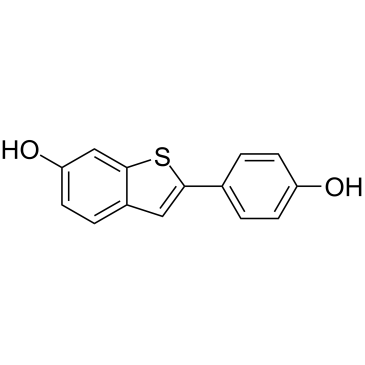| DC73820 |
SLU-PP-332
|
SLU-PP-332 is a potent, selective pan ERRα/β/γ agonist with EC50 of 98, 230 and 430 nM for ERRα, ERRβ and ERRγ, in full-length ERR cell-based cotransfection/reporter assays. |
| DC71826 |
Enclomiphene hydrochloride
|
Enclomiphene ((E)-Clomiphene) dihydrochloride is a potent and orally active non-steroidal estrogen receptor antagonist, with antioestrogenic property. Enclomiphene dihydrochloride can be used for the research of ovarian dysfunction, testosterone deficiency, male hypogonadism and type 2 diabetes. |
| DC70851 |
TTC-352
|
TTC352 is a synthetic selective estrogen mimic acts as estrogen receptor (ER) partial agonist for the treatment of endocrine-resistant breast cancer.TTC 352 yields an H-bond with Glu353, allows Asp351-to-helix 12 (H12) interaction, sealing ERα's ligand-binding domain, recruiting E2-enriched coactivators, and triggering rapid ERα-induced unfolded protein response (UPR) and apoptosis.TTC-352 is a less potent full estrogen agonist compared to E2, allowing H12 to seal the LBD, which recruits many E2-enriched coactivators, and induces rapid ERα-mediated UPR and apoptosis. |
| DC70104 |
Elacestrant
|
Elacestrant (RAD-1901) is a novel, orally bioavailable small-molecule selective estrogen receptor degrader (SERD). |
| DC44905 |
Vepdegestrant (ARV-471)
|
ARV-471 is a best-in-class, orally active estrogen receptor (ER) PROTAC degrader. ARV-471 is developed for the research of breast cancer. |
| DC40118 |
Giredestrant
|
Giredestrant (GDC-9545), a non-steroidal estrogen receptor (ER) ligand, is an orally active and selective ER antagonist. Giredestrant potently competes with Estradiol for binding and induces a conformational change within the ER ligand binding domain. Gir |
| DC28269 |
Estrogen receptor modulator 1
|
Estrogen receptor modulator 1 (compound 18) is an orally active and selective estrogen receptor modulator (SERM), with a pIC50 of 0.46. Estrogen receptor modulator 1 induces regression of Tamoxifen-resistant, hormone independent xenograft tumors. |
| DC10182 |
Elacestrant (dihydrochloride)
|
Elacestrant dihydrochloride (RAD1901 dihydrochloride) is a selective and orally available estrogen receptor (ERR) degrader with IC50 values of 48 and 870 nM for ERα and ERβ, respectively. |
| DC11658 |
Diptoindonesin G
|
Dip G is a natural compound, novel chemical probe reciprocally stabilizes ERβ and destabilizes ERα in breast cancer cells; targets CHIP ubiquitin E3 ligase to modulate ER protein stability, enhances the transcription and anti-proliferative activities of ERβ, while attenuating the transcription and proliferative effects of ERα; the first small molecule that can restore the balance of ERα and ERβ. |






















